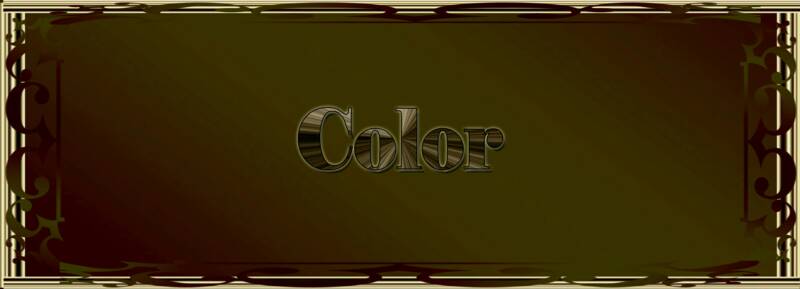Coat Color Genetics in Dobermans
Coat color inheritance in the Doberman is relatively easy to predict. While there are actually 5 colors, there are only 3 sets of genes that determine color. Basic scientific nomenclature dictates designates the recessive.
The first pair of genes we will discuss are the 2 most common, seen in all Dobes. They are three color genes, determining the basic, intrinsic color seen in the Dobie. Either Black (B) or red (b). All Dobermans are either black or red, but color can be modified by the other 2 pairs of genes. If a Doberman has 2 Black genes (BB) it will be black. If it has 2 red genes (bb) it will be red. If it has one of each (Bb) it will be a red-factored gene to it's offspring. BB animals always contribute a B gene, bb animals always contribute a b gene, and Bb animals contribute on or the other, with a 50% probability of each.
The second pair of genes we will discuss determine intensity of color. This pair of genes is called the dilution factor, seen in black Dobes as blue, and in red Dobes as fawn. Because dilution is a recessive trait, having the effect of lightening the color of black and reds, 2 of these recessive genes must be present in order to express visible influence. We will call the LACK of dilution D, and the presence of dilution d. A Doberman with DD will not show or be able to produce dilution A Doberman with fawn. A b-Black Doberman with dd is a blue and a red Doberman with dd is a fawn.
Homozygous means that the 2 gene pair match, as in BB bb. Heterozygous means there is one of each, ie, Bb, Dd.
Two more important terms are genotype and phenotype. The genotype is the Dobeis genetic potential to express a particular trait, in this case color. The phenotype describes how the Dobie look in this case, Black, Red, blue or fawn (or white - we will get to white in a minute.) There are 5 possible phenotypes. There are 27 possible genotypes, but we will only discuss nine right now.
The first is a Black Doberman that can only produce Black offspring. This Dobie genotype is BBDD. It is a Double homozygous (2 pairs of matching genes, ie BB,bb,DD dd) dominant This is referred to as a 1 Black.
The second is a Black that can produce Black and blue offspring. It is a homozygous black that carries a recessive dilution gene. Heterozygous a non matching pair of genes, ie Bb, Dd the genotype of this Dobie is BBDd. It is referred to as a #2 Black.
The third is a Black that can produce Black and red offspring it is heterozygous Bb for color, and homozygous for intensity in this case, DD it can not produce dilution. This is called a #3 Black. It's genotype is BdDD.
The fourth is a double heterozygous. It is heterozygous for color Bb, and heterozygous for dilution Dd, It carries both a hidden red gene, and a hidden gene for dilution. It is called a #4 Black., and it can produce black, rd, blue and fawn It's genotype is BdDd.
The fifth is a #5 blue. This is also a double homozygous. It is homozygous Black, BB, that is also homozygous for dilution, dd.
It can produce black and blues only. The genotype is BBdd.
The sixth is a #6 Blue. This Dobie is heterozygous for color, Bb. It is homozygous for dilution, dd it's genotype is Bbdd and it can produce Black, Red, Blues and Fawns.
The seventh is a #7 Red. This Dobie is also a double homozygous bb makes it red. DD means it can not produce dilution.
The eight is a #8 Red. This red can produce dilution. It's genotype is bbDd.
The ninth is a #9 Fawn. This is a double homozygous recessive. It contains 2 pairs of recessive genes. bb makes it red, and dd lightens the red, to fawn.
It is important to realize, that each parent contributes one gene from each pair of each of it's offspring.Therefore, each parent contributes one gene for color and one for intensity of color to each pup.
But how do you get white ??? OK. The white is a Recessive trait. A Dobie must have both genes in the pair to show white. This pair of genes is a masking factor. What is does, is it hides the true color and intensity of color of the Dobie containing this pair of genes. Because it is a recessive, a Dobie that is white, has the homozygous gene pair ww. A Dobie that has the homozygous gene pair WW is not white, has the homozygous gene pair ww. A Dobie that has the homozygous gene pair WW in not white, nor can it ever produce white. A Dobie with the gene pair Ww is white factored. This means that it caries the masking factor as a hidden recessive.
Number 1-9 listed above may or may not be WW, Ww or WW. Each of the nine above genotypes have three possibilities with respect to white. For example, a #1 black that is neither white, nor white factored has a genotype of BBDDWW - It is a triple homozygous dominant. A#1 Black that is white-factored has a genotype BBDDWW. A# 1 Black that is intensity of color genes, D and d. 3 of the masking factor genes. Wand w.
Each and every Dobie will have a pair of each genes that may be homozygous (matching pair) or heterozygous (mixed pair) if the genotypes of a pair of Dobies are know the colors of their offspring can be predicted with accuracy. The important thing to remember, however, is that predicted and actually seen to happen as predicted are not always the same. For example, rarely seen Same thing with color. If you roll a six-sided dice 6 times, you are NOT LIKELY to roll each number once, although the probability of rolling and particular number is always 1 in 6.
The White Doberman "White or "albino" Dobermans are not actually white, animals. They are a pale tan or cream colored, and only the areas which would normally be rust - colored are actually white. These Dobermans have blue eyes, not pick or red eyes. Because these dogs are not white and because they have blue eyes, some people claim that they are not actually albino. Hairs from several albino Dobermans were compared by a veterinary expert to hais from normal black, red, and blue Dobermans. The melanin pigment granules (melanosomes) are severely reduce in both number and in pigment content in an albino Doberman, as compared to normal Dobermans. That is why they are so light in color. The first ever albino Doberman was born in 1976. The mother of all Albino Dobies was registered by the AKC as White, since they believed that were found to have faults such as poor conformation, poor temperaments (aggression and fear problems, problems with trainability), multiple missing teeth, photosensitivty and sensitivity to sunburn. Although they are not "best" representatives of their breed, they require and deserve just as much love and even more care than the "normal" Dobies out there.
Info: courtesy of : Lone L Smith DVM
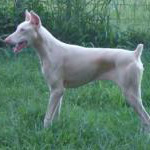
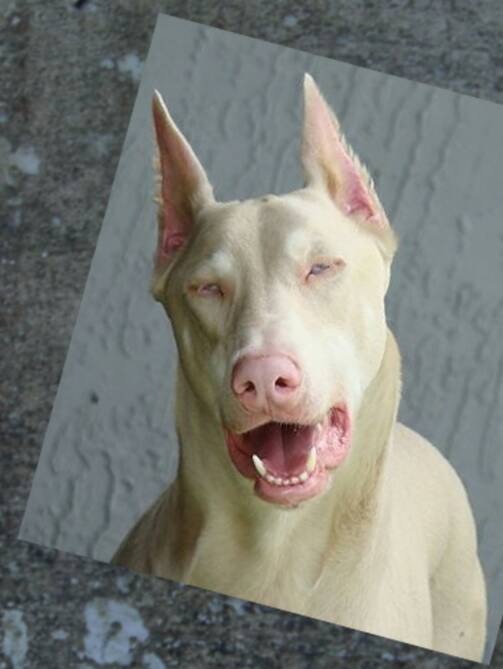
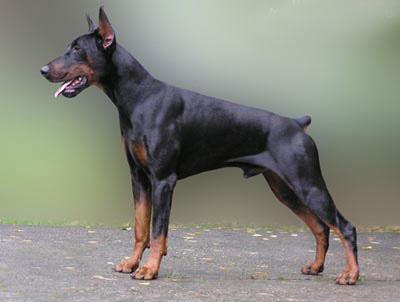
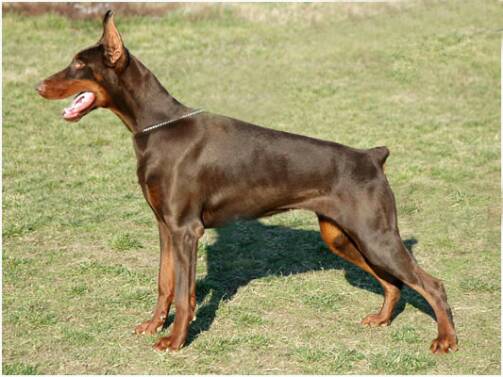
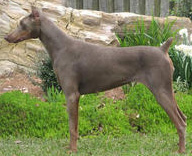
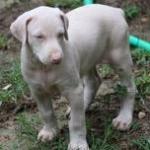
 | ||||||
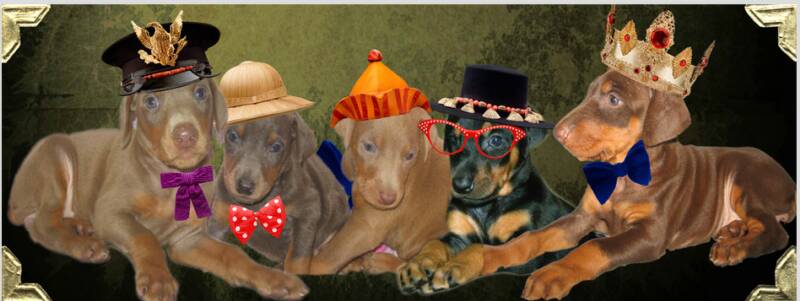
 | ||||||
